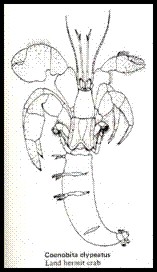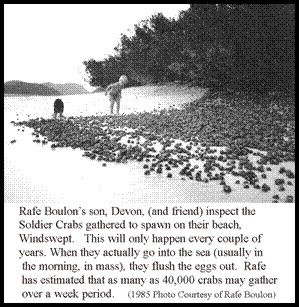Soldier Crab Saga
(Editors note: Rafe is Chief, Division of Resource Management for the Virgin Islands National Park and one of our newest Board members.)

I was born and live on St. John, USVI and have been living with Soldier (land hermit) crabs all my life. (Shown at left, without shell.) They are part of my every day life – in my pond getting a drink, around my bird cages, on my deck, in my dog’s food, on the paths we walk (carefully so as not to step on them), and in general, everywhere!! As a kid I used them for bait to fish, now I prefer to let them go on their own way, wherever that is.
During the late summer and early fall, their way is usually down to the sea to shed their eggs in the ocean. They seem to use a traditional beach where the population of crabs from that watershed aggregate over a week or so period of time before actually going to the sea and shedding their eggs. I live on one such beach. In fact, in 1985, during one of several aggregations I have seen during my lifetime, I estimated approximately 40,000 crabs in the total aggregation. This aggregation covered an area about 50 feet by 100 feet and they were piled up over a foot deep around the base of trees. I estimated numbers by using a one-square meter quadrant and randomly placing it ten times within the area occupied by the crabs. By estimating the number of crabs per square meter and multiplying that by the number of square meters occupied by crabs, I came up with approximately 40,000 crabs. This number of crabs makes an incredible sound as shells click and clank against each other. It’s a wonder many are not broken. Another amazing thing is that approximately 90% of the shells were Whelk shells, with the rest being mostly Green Star shells and a few other species. To digress, at Hawksnest I once saw a crab living in an empty guava jelly jar!! This crab was around for a couple of years until presumably the jar broke.

Once these crabs have aggregated for about a week and all the stragglers have arrived (remember they have to come from the tops of the hills), one morning, just at dawn, they make a rush for the sea. I have no idea what the cue is but they all do it together. They go down to where the waves are just washing the beach and they pump the water in and out of their shells to flush out the eggs. The sea will actually turn pink at this time and fish and seabirds will move in for a feeding frenzy. But because so many eggs are released at one time (probably several thousand per crab), enough survive to come back as soldier crabs in the future. The eggs hatch and the larvae drifts with ocean currents until near shore where it changes into a little crab, crawls up on a beach and finds a tiny shell to live in. After shedding their eggs and maybe finding a new shell, if the old one is worn, broken or too small, they head back to the hills. By nightfall that day, you only see the usual number of crabs where earlier there were thousands. One of the wonders of nature!
While our soldier crabs seem to be doing fine, I do have concerns for their long-term future. I have heard of resorts being built in traditional reproductive migration pathways and rather than design the resort to incorporate this natural phenomenon into one of their attractions, the resort management elected to exterminate the crabs. This resulted in a watershed on St. Croix with no soldier crabs. Being that these crabs have a great dependence on the availability of shells (mostly whelk) in a variety of sizes to enable growth, the over harvest of whelk in particular may be having a serious affect on this species. You rarely see large whelk anymore and this must limit the size to which our crabs can grow. The larger the crab, the more eggs they can produce so this could have long-term effects on the overall populations of Soldier crabs on St. John and throughout the Caribbean. While few people still use them for fish bait, I’m sure the collection of crabs for this purpose had an impact on the populations in the past, from which they seem to have recovered. Roads have also had an impact where crabs have to cross them to reach an aggregation site and then return. So next time you see a Soldier crab, reflect for a moment on what these little guys have to go through to survive. It’s amazing to think that once a year or so, some of them make the trip from Bordeaux Mountain to the ocean and back!
See
[Natural history]
